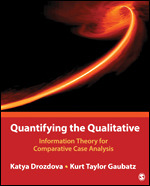Quantifying the Qualitative
Information Theory for Comparative Case Analysis
- Katya Drozdova - Seattle Pacific University, USA
- Kurt Taylor Gaubatz - Old Dominion University, Norfolk, USA
Supplements
“[Quantifying the Qualitative] gives students the tools they need to enhance systematic case-study analysis.”
“[This text] is a new and fresh approach to learning how to analyze case studies from a qualitative research paradigm that faculty can use and students can wrap their heads around.”
“[This book] just oozes with policy recommendations and future research...a huge contribution.”
“[This text introduces] more contemporary tools to address questions that are important to the world now.”




